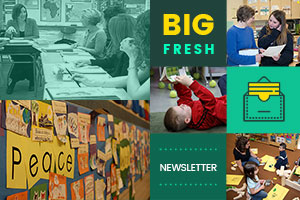I have measured out my life in coffee spoons.
T. S. Eliot
My husband and I were sitting in the trendy cafe, enjoying our tea and coffee, savoring the cinnamon roll we were sharing. We were probably the only two people there not dressed in jeans with torn-out spots, or in black leggings; the only two without messy ponytails or man-buns.
“I’m feeling obsolete,” I said ruefully, though without even the smallest desire to trade my age or station in life with these young people.
This feeling of being out of sync with younger generations is, for me, most acute in my classroom. I come from a very different culture than my fifth graders. It is downright weird to them that I don’t play video games, would rather read than watch TV or movies, actually choose to write, and spend time outdoors in all weather and temperatures.
It occurred to me as I sipped my tea that every generation has been taught by a previous generation unlike theirs that doesn’t really “get” the new generation. The generation that taught me was sure that the evil of television would rot our minds and cause civilization to collapse. In turn, my generation looks at the ways screen time is rewiring the brains of the students we teach and has similar worries.
Cave people taught their children to hunt long after farming became more practical. Parents taught their children to change the oil in their cars even as cars were becoming too complicated and automated for owners to do basic service. I continue to have my students keep writer’s notebooks in spite of the fact that their writing lives are becoming almost completely digital.
“Why do we even bother with education if there’s always a generational lag?” I wondered aloud. Before my husband had a chance to respond, I knew the answer. It’s the constant that has guided my entire career: process over product. More than any set of concrete facts, I have worked all these years to teach my students curiosity, perseverance, compassion, collaboration, acceptance of others, and basic good manners. They have learned to hold questions in their minds as they read, to group their ideas into paragraphs when writing, to find patterns in math, and to consider both sides of an issue.
Looking again at the young people around us in the cafe, I saw a family with a young child who was playing at the table with toy cars, rather than interacting with a screen. There was a girl reading a book while she nursed a cappuccino. And the young man at the table next to us was talking with his tablemate about the social justice work with which he’d been involved.
Our education system is not perfect in ways much bigger than the generation gap between teachers and students. But the power of process over a single uniform product seemed to be in evidence all around me in that cafe. And that gave me a burst of hope for the future.
This week we look at ways to build better book clubs. Plus more as always—enjoy!
Contributor, Choice Literacy
Mary Lee Hahn has been teaching fourth or fifth graders for more than 30 years. She is the author of Reconsidering Read-Aloud (Stenhouse Publishers). Mary Lee and her colleague Franki Sibberson blog about their reading lives and a whole lot more at A Year of Reading.

Tammy Mulligan shares the importance of giving students choice and agency with book club tools to improve engagement and the quality of the conversations.
Mary Lee Hahn considers how book clubs have changed over time in her fifth-grade classroom.
Lorraine Radice explains why book clubs are a winning instructional strategy in any learning environment, including remote settings.
LAST CHANCE to register until December! We are now offering a virtual field experience through the over 900 classroom videos from grades K-8 on the site, featuring top teachers from around the country. We’ve developed this $49 option as an alternative to a traditional fieldwork experience, and it includes a three-month Classic Classroom membership. You can read more about it and register here.
Our courses are being redesigned and will be released in December. At that time, all courses will be free for Literacy Leader members, and select courses will be free for Classic Classroom members.

New members-only content is added each week to the Choice Literacy website. If you’re not yet a member, click here to explore membership options.
Gretchen Schroeder‘s students are almost all white and live in a rural community. She finds book clubs are a wonderful tool for expanding cultural awareness.
Tara Barnett and Kate Mills find that book clubs succeed when students are eased into them and given thoughtful tools to prepare for group discussions.
In this week’s video, Lora Bieghler facilitates a Socratic discussion among third graders to build conversation skills.
In an encore video, Dana Murphy leads a minilesson on book club conversations, using a fishbowl strategy and building blocks to support more sophisticated conversations.

Matt Renwick is disappointed by something he sees when he visits a teacher’s classroom. This leads him to ponder what his role is in supporting teachers with choice as they make changes in their classrooms and instruction.
New PD2Go: This video and accompanying workshop guide provide suggestions from Dana Murphy and Gretchen Schroeder for supporting sophisticated book club conversations. Discover a practical strategy for students to build on conversations, and consider fostering cultural awareness through book choices.
Jennifer Gonzalez provides a treasure trove of resources for making cooperative learning work better. There are many useful links here to share with teachers in on-site or remote professional development.
Quote It:
You must be able to say “I understand,” before you can say “I agree,” or “I disagree,” or “I suspend judgment.”
Mortimer J. Adler
That’s all for this week!



